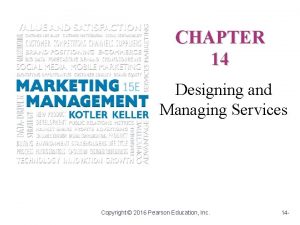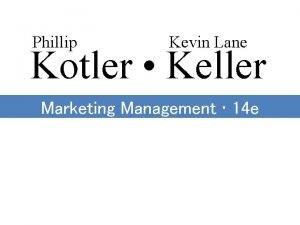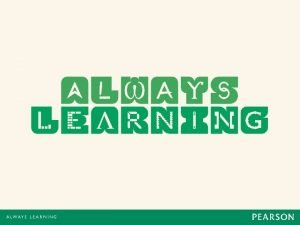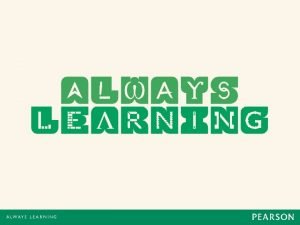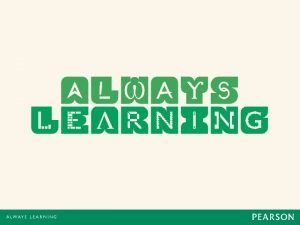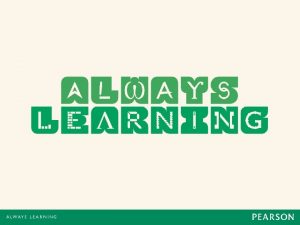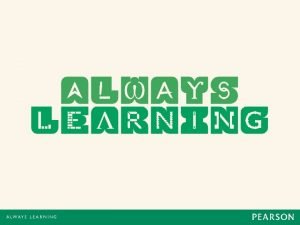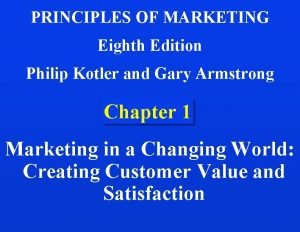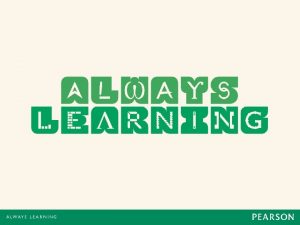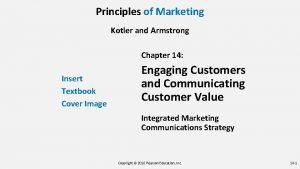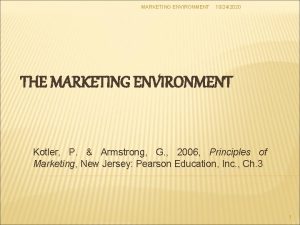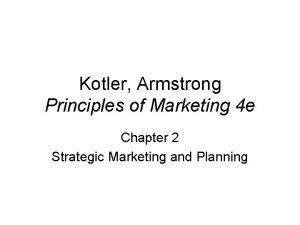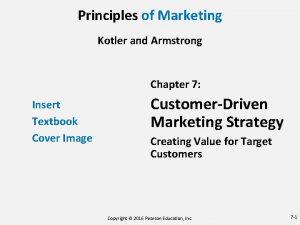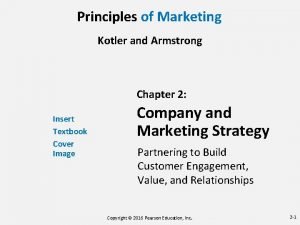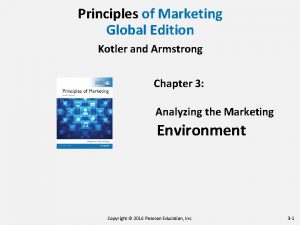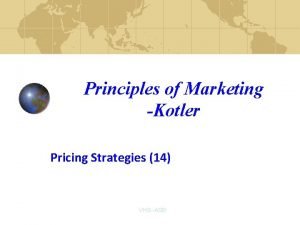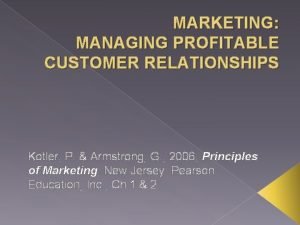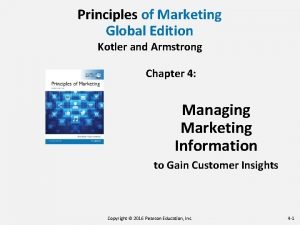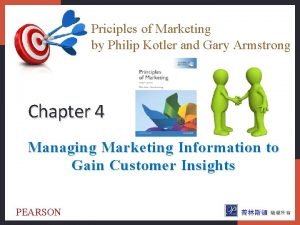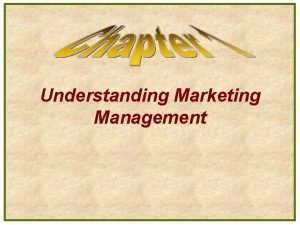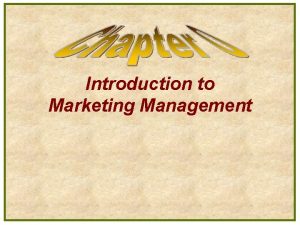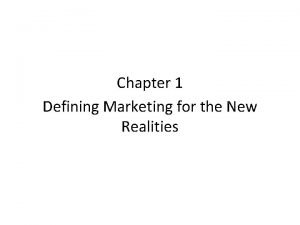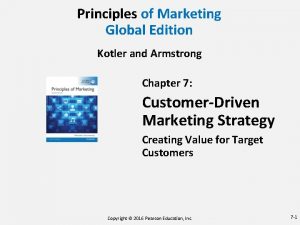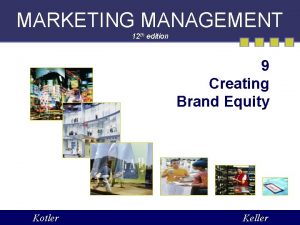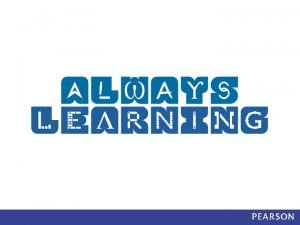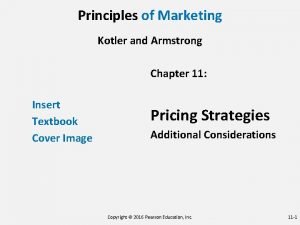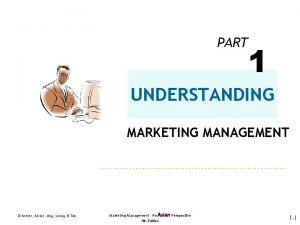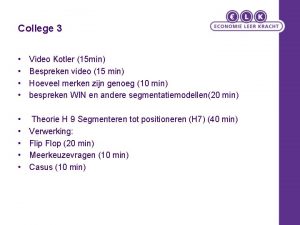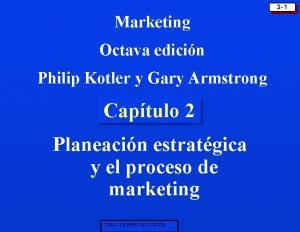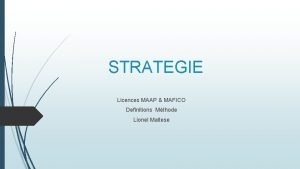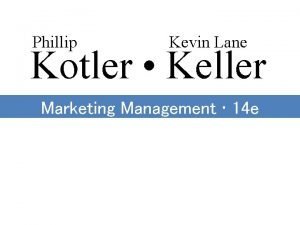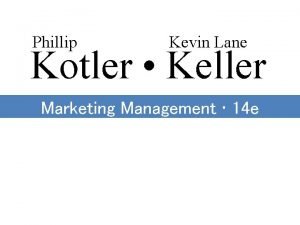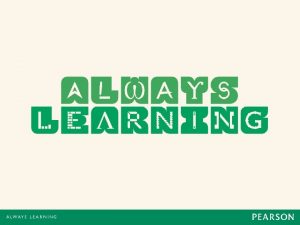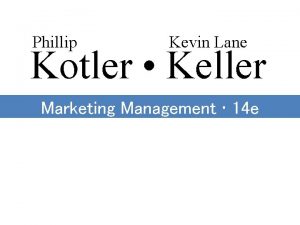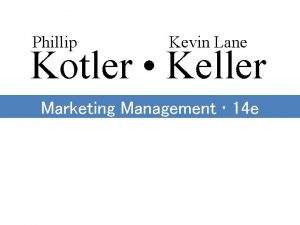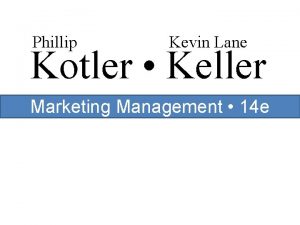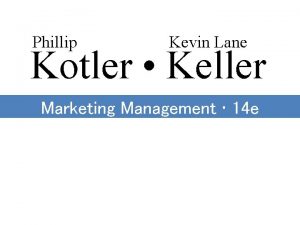Marketing Management 15 e Chapter 1 Kotler Keller

















































- Slides: 49

Marketing Management • 15 e Chapter 1 Kotler • Keller Defining marketing for the new realities Dr. Rushdy A. Wady

Chapter Questions 1. Why is marketing important? 2. What is the scope of marketing? 3. What are some core marketing concepts? 4. What forces are defining the new marketing realities? 5. What new capabilities have these forces given consumers and companies? 6. What does a holistic marketing philosophy include? 7. What tasks are necessary for successful marketing management? Copyright © 2011 Pearson Education, Inc. Publishing as Prentice Hall 1 -2

What is Marketing? Marketing is an organizational function and a set of processes for creating, communicating, and delivering value to customers and for managing customer relationships in ways that benefit the organization and its stakeholders. Or marketing is “meeting needs profitably. ” Copyright © 2011 Pearson Education, Inc. Publishing as Prentice Hall 1 -3

What is Marketing Management? Marketing management is the art and science of choosing target markets and getting, keeping, and growing customers through creating, delivering, and communicating superior customer value. Copyright © 2011 Pearson Education, Inc. Publishing as Prentice Hall 1 -4

The Value of Marketing Financial success often depends on marketing ability. Marketing builds strong brands and a loyal customer base. Copyright © 2011 Pearson Education, Inc. Publishing as Prentice Hall 1 -5

What is Marketed? • Goods • Services • Events • Experiences • Persons Copyright © 2011 Pearson Education, Inc. Publishing as Prentice Hall 1 -6

What is Marketed? • Places: states, regions, and whole nations compete to attract tourists. • Properties: real estates, stocks and bonds. • Organizations: Museums, performing arts organizations, corporations, and nonprofits all use marketing to boost their public images and compete for audiences and funds. • Information: is essentially what books, schools, and universities produce. • Ideas: Products and services are platforms for delivering some idea or benefit. Copyright © 2011 Pearson Education, Inc. Publishing as Prentice Hall 1 -7

WHO MARKETS? Copyright © 2011 Pearson Education, Inc. Publishing as Prentice Hall 1 -8

Demand States Eight demand states are possible: 1. Negative demand: Consumers dislike the product. 2. Nonexistent demand: Consumers may be unaware of or uninterested in the product. 3. Latent demand: Consumers may share a strong need that cannot be satisfied by an existing product. 4. Declining demand: Consumers begin to buy the product less frequently or not at all. Copyright © 2011 Pearson Education, Inc. Publishing as Prentice Hall 1 -9

Demand States 5. Irregular demand: Consumer purchases vary on a seasonal, monthly, weekly, daily, or even hourly basis. 6. Full demand: Consumers are adequately buying all products put into the marketplace. 7. Overfull demand: More consumers would like to buy the product than can be satisfied. 8. Unwholesome demand: Consumers may be attracted to products that have undesirable social consequences. Copyright © 2011 Pearson Education, Inc. Publishing as Prentice Hall 1 -10

In each case, marketers must identify the underlying cause(s) of the demand state and determine a plan of action to shift demand to a more desired state. MARKETS Traditionally, a “market” was a physical place where buyers and sellers gathered to buy and sell goods.

| Fig. 1. 1 | Structure of Flows in a Modern Exchange Economy Copyright © 2011 Pearson Education, Inc. Publishing as Prentice Hall 1 -12

Figure 1. 2 A Simple Marketing System Copyright © 2011 Pearson Education, Inc. Publishing as Prentice Hall 1 -13

Key Customer Markets Consumer markets: Business markets: Global markets: Nonprofit/Government markets: . Copyright © 2011 Pearson Education, Inc. Publishing as Prentice Hall 1 -14

Governments are a key customer market for many companies. Copyright © 2011 Pearson Education, Inc. Publishing as Prentice Hall 1 -15

Core Marketing Concepts Needs, Wants, and Demands Target Markets, Positioning, and Segmentation Offerings and Brands Marketing Channels Paid, Owned, and Earned Media Impressions and Engagement Value and Satisfaction Supply Chain Competition Marketing Environment Copyright © 2011 Pearson Education, Inc. Publishing as Prentice Hall 1 -16

Types of Needs Stated needs: what the customer asks for (an inexpensive car). Real needs: what the stated need really means (The customer wants a car whose operating cost, not initial price, is low. ) Unstated needs: (The customer expects good service from the dealer. ) Delight needs: (The customer would like the dealer to include an onboard GPS system. ) Secret needs: (The customer wants friends to see him or her as a savvy consumer. ) Copyright © 2011 Pearson Education, Inc. Publishing as Prentice Hall 1 -17

Target Markets, Positioning & Segmentation Marketers identify distinct segments of buyers by identifying demographic, psychographic, and behavioral differences between them. They then decide which segment(s) present the greatest opportunities. For each of these target market the firm develops a market offering that it positions in target buyers’ minds as delivering some key benefit(s). Copyright © 2011 Pearson Education, Inc. Publishing as Prentice Hall 1 -18

Target Markets, Positioning & Segmentation Copyright © 2011 Pearson Education, Inc. Publishing as Prentice Hall 1 -19

Offerings and Brands The company offering a set of benefits that satisfy costumer needs, which can be a combination of products, services, information, and experiences. A brand is an offering from a known source. Copyright © 2011 Pearson Education, Inc. Publishing as Prentice Hall 1 -20

Marketing Channels To reach a target market, the marketer uses three kinds of marketing channels: 1 - Communication channels deliver and receive messages from target buyers. 2 - Distribution channels help display, sell, or deliver the physical product or service(s) to the buyer or user. 3 - Service channels to carry out transactions with potential buyers. Copyright © 2011 Pearson Education, Inc. Publishing as Prentice Hall 1 -21

PAID, OWNED, AND EARNED MEDIA The rise of digital media gives marketers a host of new ways to interact with consumers and customers. Paid media: TV, Magazine and display ads. Owned Media: web sit, blog, Facebook page, Twitter account. Earned media: in which consumers, the press, or other outsiders voluntarily communicate something about the brand via word of mouth, buzz, or viral marketing methods. Copyright © 2011 Pearson Education, Inc. Publishing as Prentice Hall 1 -22

IMPRESSIONS AND ENGAGEMENT Marketers now think of three “screens” or means to reach consumers: TV, Internet, and mobile. Copyright © 2011 Pearson Education, Inc. Publishing as Prentice Hall 1 -23

Value and Satisfaction The buyer chooses the offerings he or she perceives to deliver the most value the sum of the tangible and intangible benefits and costs. Value, a central marketing concept, is primarily a combination of quality, service, and price (qsp), called the customer value triad. Value perceptions increase with quality and service but decrease with price. Copyright © 2011 Pearson Education, Inc. Publishing as Prentice Hall 1 -24

SUPPLY CHAIN The supply chain is a channel stretching from raw materials to components to finished products carried to final buyers. Copyright © 2011 Pearson Education, Inc. Publishing as Prentice Hall 1 -25

The Supply Chain for Coffee Copyright © 2011 Pearson Education, Inc. Publishing as Prentice Hall 1 -26

COMPETITION Competition includes all the actual and potential rival offerings and substitutes a buyer might consider. Copyright © 2011 Pearson Education, Inc. Publishing as Prentice Hall 1 -27

Marketing Environment Demographic Economic Socio-cultural Political-legal Technological Natural Marketers must pay close attention to the trends and developments in these and adjust their marketing strategies as needed. Copyright © 2011 Pearson Education, Inc. Publishing as Prentice Hall 1 -28

The New Marketing Realities Copyright © 2011 Pearson Education, Inc. Publishing as Prentice Hall 1 -29

The New Marketing Realities Three transformative forces: 1 - Technology: 2 - Globalization: . 3 - Social responsibility: Copyright © 2011 Pearson Education, Inc. Publishing as Prentice Hall 1 -30

What new capabilities have these forces given consumers and companies? NEW CONSUMER CAPABILITIES: Can use the Internet as a powerful information and purchasing aid. Can search, communicate, and purchase on the move. Can tap into social media to share opinions and express loyalty. Can actively interact with companies. Can reject marketing they find inappropriate. Copyright © 2011 Pearson Education, Inc. Publishing as Prentice Hall 1 -31

What new capabilities have these forces given consumers and companies? NEW COMPANY CAPABILITIES: Can use the Internet as a powerful information and sales channel, including for individually differentiated goods. Can collect fuller and richer information about markets, customers, prospects, and competitors. Can reach customers quickly and efficiently via social media and mobile marketing. Can improve purchasing, recruiting, training, and internal and external communications. Can improve cost efficiency.

Company Orientation toward the Marketplace Production Product Selling Marketing Holistic marketing concept Copyright © 2011 Pearson Education, Inc. Publishing as Prentice Hall 1 -33

The production concept It holds that consumers prefer products that are widely available and inexpensive. Managers of production-oriented businesses concentrate on achieving high production efficiency, low costs, and mass distribution. Copyright © 2011 Pearson Education, Inc. Publishing as Prentice Hall 1 -34

The product concept The Product concept proposes that consumers favor products offering the most quality, performance, or innovative features. They might commit the “bettermousetrap” fallacy, believing a better product will by itself lead people to beat a path to their door. Copyright © 2011 Pearson Education, Inc. Publishing as Prentice Hall 1 -35

The selling concept holds that consumers and businesses, if left alone, won’t buy enough of the organization’s products. It is practiced most aggressively with unsought goods—goods buyers don’t normally think of buying such as insurance and cemetery plots—and when firms with overcapacity aim to sell what they make, rather than make what the market wants. Copyright © 2011 Pearson Education, Inc. Publishing as Prentice Hall 1 -36

The marketing concept The job is to find not the right customers for your products, but the right products for your customers. The marketing concept holds that the key to achieving organizational goals is being more effective than competitors in creating, delivering, and communicating superior customer value to your target markets. Copyright © 2011 Pearson Education, Inc. Publishing as Prentice Hall 1 -37

The holistic marketing concept is based on the development, design, and implementation of marketing programs, processes, and activities that recognize their breadth and interdependencies. Holistic marketing acknowledges that everything matters in marketing— and that a broad, integrated perspective is often necessary. Copyright © 2011 Pearson Education, Inc. Publishing as Prentice Hall 1 -38

The holistic marketing concept Holistic marketing thus recognizes and reconciles the scope and complexities of marketing activities. Four components characterizing holistic marketing: relationship marketing, integrated marketing, internal marketing, and performance marketing. Copyright © 2011 Pearson Education, Inc. Publishing as Prentice Hall 1 -39

Holistic Marketing Copyright © 2011 Pearson Education, Inc. Publishing as Prentice Hall 1 -40

Relationship Marketing Relationships with people and organizations that directly or indirectly affect the success of the firm’s marketing activities. Four key constituents for relationship marketing are customers, employees, marketing partners (channels, suppliers, distributors, dealers, agencies), and members of the financial community (shareholders, investors, analysts). Copyright © 2011 Pearson Education, Inc. Publishing as Prentice Hall 1 -41

Integrated Marketing Integrated marketing occurs when the marketer devises marketing activities and assembles marketing programs to create, communicate, and deliver value for consumers such that “the whole is greater than the sum of its parts. ” Copyright © 2011 Pearson Education, Inc. Publishing as Prentice Hall 1 -42

Internal Marketing Internal marketing is the task of hiring, training, and motivating able employees who want to serve customers well. Copyright © 2011 Pearson Education, Inc. Publishing as Prentice Hall 1 -43

Performance Marketing requires understanding the financial and nonfinancial returns and society from marketing activities and programs. Copyright © 2011 Pearson Education, Inc. Publishing as Prentice Hall 1 -44

The Marketing Mix “A set of marketing tools that the firm uses to pursue its marketing objectives in the target market" Copyright © 2011 Pearson Education, Inc. Publishing as Prentice Hall 1 -45

Updating the Four Ps People: reflects, in part, internal marketing and the fact that employees are critical to marketing success. Processes: reflects all the creativity, discipline, and structure brought to marketing management. Programs: reflects all the firm’s consumer-directed activities. We define performance as in holistic marketing. Copyright © 2011 Pearson Education, Inc. Publishing as Prentice Hall 1 -46

Marketing Management Tasks Develop market strategies and plans Capture marketing insights Connect with customers Build strong brands Create value Deliver value Communicate value Conduct marketing responsibility for long-term success. Copyright © 2011 Pearson Education, Inc. Publishing as Prentice Hall 1 -47

The New Marketing Realities Copyright © 2011 Pearson Education, Inc. Publishing as Prentice Hall 1 -48

For Review 1. Why is marketing important? 2. What is the scope of marketing? 3. What are some core marketing concepts? 4. What forces are defining the new marketing realities? 5. What new capabilities have these forces given consumers and companies? 6. What does a holistic marketing philosophy include? 7. What tasks are necessary for successful marketing management? Copyright © 2011 Pearson Education, Inc. Publishing as Prentice Hall 1 -49
 Negative demand
Negative demand Kotler e keller
Kotler e keller Services are typically produced and consumed simultaneously
Services are typically produced and consumed simultaneously Mantras de kotler
Mantras de kotler Marketing management (arab world edition) philip kotler
Marketing management (arab world edition) philip kotler Marketing management (arab world edition) philip kotler
Marketing management (arab world edition) philip kotler What is the value delivery process
What is the value delivery process Marketing management (arab world edition) philip kotler
Marketing management (arab world edition) philip kotler Marketing management (arab world edition) philip kotler
Marketing management (arab world edition) philip kotler Principles of marketing philip kotler
Principles of marketing philip kotler Marketing management (arab world edition)
Marketing management (arab world edition) Marketing information system kotler
Marketing information system kotler 14 principles of marketing
14 principles of marketing Marketing information system kotler
Marketing information system kotler Marketing information system kotler
Marketing information system kotler Marketing information system kotler
Marketing information system kotler Marketing information management definition
Marketing information management definition Philip kotler marketing environment
Philip kotler marketing environment Marketing plan kotler
Marketing plan kotler Marketing information system kotler
Marketing information system kotler Principles of marketing philip kotler ppt
Principles of marketing philip kotler ppt Ethical values in marketing
Ethical values in marketing Stp marketing kotler
Stp marketing kotler Principles of marketing chapter 2
Principles of marketing chapter 2 Kotler and armstrong principles of marketing
Kotler and armstrong principles of marketing Marketing kotler
Marketing kotler Kotler's pricing strategy
Kotler's pricing strategy Marketing kotler
Marketing kotler Mak leha
Mak leha Marketing research process kotler
Marketing research process kotler 3 types of marketing research
3 types of marketing research Marketing meaning in marketing management
Marketing meaning in marketing management Marketing meaning in marketing management
Marketing meaning in marketing management Marketing meaning in marketing management
Marketing meaning in marketing management Defining marketing for new realities
Defining marketing for new realities Juana bormann
Juana bormann Positioning kotler
Positioning kotler Forecasting and demand measurement in marketing
Forecasting and demand measurement in marketing Creating brand equity kotler
Creating brand equity kotler Good competitors
Good competitors The boy in the striped pajamas blonde soldier
The boy in the striped pajamas blonde soldier Kotler pricing strategies
Kotler pricing strategies Keller
Keller Five product levels
Five product levels Positionering kotler
Positionering kotler Afroompolitiek
Afroompolitiek Modelo de comportamiento del consumidor kotler
Modelo de comportamiento del consumidor kotler Kotler 2002
Kotler 2002 Licence mafico
Licence mafico Estrategias de kotler
Estrategias de kotler


